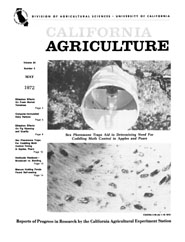


University of California
California Agriculture
|
|||
|
|||

Sex pheromone traps aid in determining need for coddling moth control in apples and pears.
May 1972
Volume 26, Number 5 News and opinion |
|||
|
University of California, 1301 S. 46th St., Bldg. 478 Richmond, CA
|